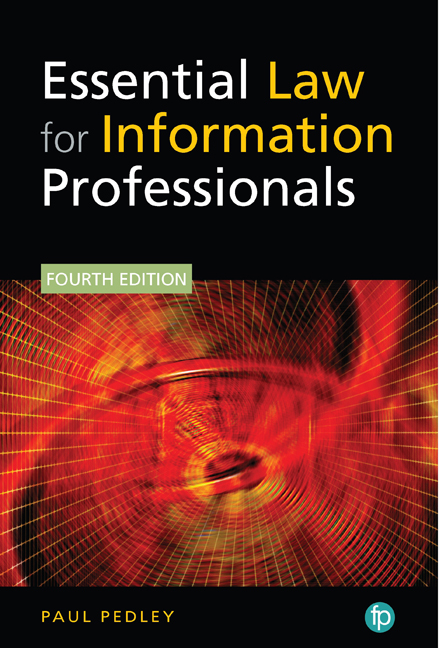Book contents
- Frontmatter
- Dedication
- Contents
- Disclaimer
- List of Figures and Tables
- Table of Statutes, Etc.
- Table of Cases
- Abbreviations
- Glossary of Terms
- Preface
- Chapter 1 General law and background
- Chapter 2 Library Law
- Chapter 3 Copyright
- Chapter 4 Legal Deposit
- Chapter 5 Breach of Confidence
- Chapter 6 Contracts and Licensing Agreements
- Chapter 7 Data Protection
- Chapter 8 Privacy
- Chapter 9 Freedom of Information
- Chapter 10 Human Rights
- Chapter 11 Re-use of Public Sector Information
- Chapter 12 Defamation
- Chapter 13 Professional Liability
- Chapter 14 Cybersecurity and Cybercrime
- Chapter 15 Disability Discrimination
- Chapter 16 Other Legal Issues Relevant to Librarians
- References
- Appendix 1 Brexit and the Orphan Works Exception
- Appendix 2 CILIP'S Ethical Framework
- Index
Chapter 14 - Cybersecurity and Cybercrime
Published online by Cambridge University Press: 27 March 2020
- Frontmatter
- Dedication
- Contents
- Disclaimer
- List of Figures and Tables
- Table of Statutes, Etc.
- Table of Cases
- Abbreviations
- Glossary of Terms
- Preface
- Chapter 1 General law and background
- Chapter 2 Library Law
- Chapter 3 Copyright
- Chapter 4 Legal Deposit
- Chapter 5 Breach of Confidence
- Chapter 6 Contracts and Licensing Agreements
- Chapter 7 Data Protection
- Chapter 8 Privacy
- Chapter 9 Freedom of Information
- Chapter 10 Human Rights
- Chapter 11 Re-use of Public Sector Information
- Chapter 12 Defamation
- Chapter 13 Professional Liability
- Chapter 14 Cybersecurity and Cybercrime
- Chapter 15 Disability Discrimination
- Chapter 16 Other Legal Issues Relevant to Librarians
- References
- Appendix 1 Brexit and the Orphan Works Exception
- Appendix 2 CILIP'S Ethical Framework
- Index
Summary
Background
Cybercrime and computer misuse covers a wide range of activities. These include:
• Botnets – a network of private computers infected with malicious software and controlled as a group without the knowledge of the computer's owner.
• Copyright abuse – copyright infringement or piracy is the use of works protected by copyright law without the permission of the copyright holder.
• Cyber bullying – a form of bullying or harassment which uses electronic means.
• Cyber espionage – use of computer networks to obtain illicit access to confidential information. It is the act of obtaining secrets and information without the knowledge or permission of the holder from individuals, competitors, governments and enemies.
• Cyber terrorism – the politically motivated use of computers and the internet to conduct violent acts which result in or threaten the loss of life or significant bodily harm.
• Denial of service attack (see Section 14.11) – hackers attempt to prevent legitimate users from accessing the service. It usually involves sending a large amount of messages asking the network or server to authenticate requests that have invalid return addresses thereby keeping the network or server busy.
• Hacking (see Section 14.6) – gaining unauthorised access into a system or computer. Hackers could potentially steal or destroy data or prevent authorised users from accessing the system.
• Malware – malicious software designed to damage, disrupt or gain access to a computer system to cause harm. Malware can perform functions such as stealing, encrypting or deleting sensitive data, or monitoring a computer user's activity without their knowledge or permission.
• Pharming (see Section 14.10.2) – the act of directing internet users to a bogus website which mimics the appearance of a legitimate one in order to obtain personal information.
• Phishing (14.10.1) – the fraudulent practice of sending emails to people which claim to be from a reputable company in order to induce them to reveal personal information
• Ratting – hacking into a computer to take control of its functions. Derived from RAT or remote access tool.
• Revenge porn – posting on the internet sexually explicit images or videos without the consent of the subject, in order to cause them distress or embarrassment. Typically carried out by a former sexual partner.
- Type
- Chapter
- Information
- Essential Law for Information Professionals , pp. 283 - 304Publisher: FacetPrint publication year: 2019



